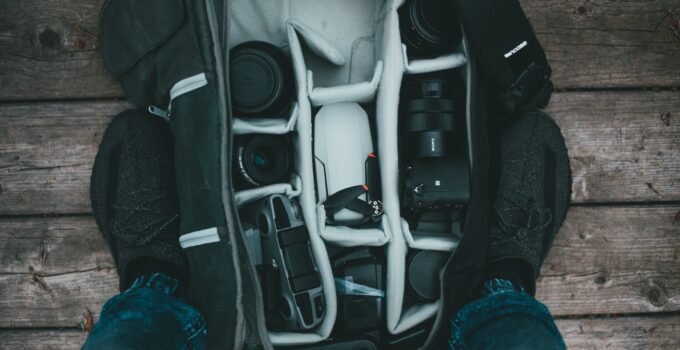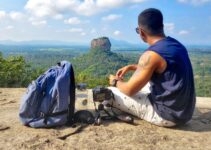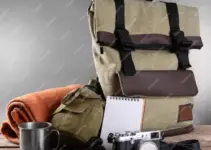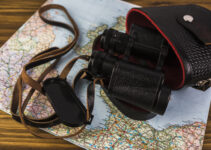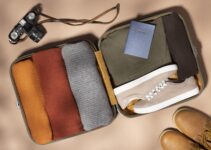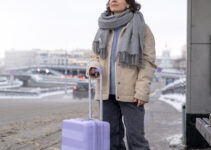When it comes to carrying your precious camera gear, a reliable and well-designed camera bag is a must-have accessory.
But with countless options available, how do you choose the right one? And What to look for in a camera bag? Whether you’re a professional photographer or an avid hobbyist, knowing what to look for in a camera bag can make all the difference.
In this article, we will explore the essential features that should be on your radar when selecting a camera bag.
From size and durability to organization and comfort, we’ll guide you through the process of finding the perfect bag to keep your gear safe and accessible during your photography adventures.
What to look for in a camera bag? (9 Ways revealed)
Here take a look some factors that helps you to choose a camera bag for your adventure.
1. Size
When choosing a camera bag, size is an essential factor to consider. It should be spacious enough to accommodate your camera body, lenses, and other accessories comfortably.
Look for compartments or dividers that allow for organization and protection of your gear.
Additionally, ensure the bag is compact and lightweight, making it easy to carry around. A well-sized camera bag ensures convenience and efficient storage for all your photography equipment.
2. Flight considerations
When selecting a camera bag, flight considerations are important to keep in mind. Look for a bag that meets the airline’s carry-on size restrictions, allowing you to bring your camera gear on board without the risk of checking it in.
Some camera bags are designed specifically for air travel, featuring TSA-friendly compartments or removable inserts for security screening.

Ensuring your camera bag complies with flight regulations ensures peace of mind and protects your valuable equipment during travel.
3. Extra features
When choosing a camera bag, consider the extra features it offers. Look for features like weather resistance or waterproofing to protect your gear in challenging conditions.
Padded straps and back panels provide comfort during extended use. Additional pockets or compartments for personal items like a water bottle or a laptop can be useful.
Some camera bags also offer tripod carrying options or attachment points for accessories.
Evaluating these extra features will help you find a camera bag that suits your specific needs and enhances your photography experience.
4. Styles
When searching for a camera bag, consider the different styles available. There are various options such as backpacks, shoulder bags, sling bags, and messenger bags.
Each style offers distinct advantages based on your preferences and shooting style. Backpacks provide even weight distribution and ample storage, while shoulder bags offer quick access to gear.
Sling bags offer a balance between accessibility and comfort, and messenger bags provide a stylish and versatile option. Choose a style that aligns with your needs, comfort, and personal aesthetic.
5. Access
When selecting a camera bag, access is a crucial aspect to consider. Look for a bag that offers convenient and quick access to your camera and equipment.
Features such as side or top openings, quick-release buckles, or easy-access compartments allow you to retrieve your gear efficiently, enabling you to capture spontaneous moments without delay.
Consider how the bag’s design and access points align with your shooting style and the type of photography you engage in to ensure a smooth and seamless workflow.
6. Build quality and weight
When choosing a camera bag, pay attention to its build quality and weight. Opt for a bag made of durable materials like nylon or polyester that can withstand daily use and protect your gear. Reinforced stitching and sturdy zippers ensure longevity.
Additionally, consider the weight of the bag, as it should be comfortable to carry for extended periods.
Look for lightweight options that won’t add unnecessary strain. Balancing build quality and weight ensures a reliable and comfortable camera bag for your photography adventures.
7. Backpacks
When considering a camera bag, backpacks are a popular and practical choice. Look for backpacks specifically designed for camera gear, with padded compartments and dividers to protect and organize your equipment.
Adjustable shoulder straps and back padding ensure comfort during long photo shoots or hikes. Consider additional features like tripod carrying options, laptop compartments, and external pockets for easy access to essentials.
Backpacks offer excellent weight distribution and versatility, making them a preferred option for photographers who require mobility and extensive gear storage.
Here you can look up how to carry a bridge camera without a camera bag?
8. Comfort
Comfort is a crucial factor when selecting a camera bag. Look for features that prioritize comfort during prolonged use. Padded shoulder straps and back panels provide support and cushioning.
Adjustable straps help distribute the weight evenly across your body. Consider ergonomic designs that reduce strain on your back and shoulders.
Additionally, look for breathable materials that prevent excessive sweating. Prioritizing comfort ensures that carrying your camera gear for extended periods is more enjoyable and reduces the risk of fatigue or discomfort.
9. Internal Dividers
When choosing a camera bag, internal dividers play a crucial role in organizing and protecting your equipment. Look for a bag that offers customizable dividers, allowing you to create compartments that suit your specific gear setup.

The dividers should be well-padded and adjustable to securely hold your camera body, lenses, and accessories in place, preventing them from knocking into each other.
With effective internal dividers, you can ensure that your gear remains organized, easily accessible, and safe from scratches or damage while on the move.
Related faq’s
How do I choose a camera bag?
When choosing a camera bag, there are several factors to consider. First, assess the size of your camera gear and ensure the bag has enough space to accommodate it comfortably.
Look for compartments and dividers to keep your equipment organized. Consider the bag’s build quality and weight, opting for durable materials and a manageable weight for your needs.
Assess the bag’s access points, ensuring quick and convenient access to your gear. Additionally, consider the bag’s style, such as backpacks or shoulder bags, based on your preferences and shooting style. Lastly, prioritize comfort, looking for features like padded straps and back panels.
By evaluating these factors, you can find a camera bag that meets your specific requirements and enhances your photography experience.
What should be in every camera bag?
There are several essential items that should be in every camera bag to ensure a smooth and successful photography experience:
- Camera body: The main component of your camera gear setup.
- Lenses: Carry the lenses you commonly use, such as a wide-angle lens, a standard zoom lens, and a telephoto lens, based on your photography needs.
- Memory cards: Have an ample supply of memory cards to store your photos and videos.
- Extra batteries: Carry spare batteries to ensure you don’t run out of power during shoots.
- Battery charger: A charger to recharge your camera batteries when needed.
- Lens cleaning kit: Keep your lenses clean and free from dust and smudges with a microfiber cloth and lens cleaning solution.
- Tripod: A sturdy tripod provides stability for long exposures, low-light situations, or self-portraits.
- Camera remote or cable release: Useful for reducing camera shake during long exposures or when you want to be in the photo.
- Lens filters: Filters such as UV filters, polarizers, or neutral density filters can enhance your images and protect your lenses.
- Lens hood: Helps reduce lens flare and protects the front element of your lens.
- Camera manual: Keep a copy of your camera’s manual for reference.
- Pen and notebook: Useful for taking notes, writing down settings, or jotting down ideas.
- Rain cover: Protect your camera and gear from inclement weather conditions.
- Personal items: Carry personal items like a water bottle, snacks, and a small first aid kit.
Remember to consider the size and weight of your camera bag and choose the items based on your specific shooting style and needs.
Here you can check out how to set up a camera bag?
What should I look for in a camera quality?
When evaluating camera quality, there are several key factors to consider:
- Image Sensor: The size and type of image sensor significantly impact image quality. Larger sensors generally capture more light and produce better image quality with less noise.
- Megapixels: Higher megapixel counts allow for more detailed images, especially for large prints or cropping. However, excessively high megapixel counts may not always translate to better image quality, so consider your specific needs.
- ISO Performance: The camera’s ability to handle low-light situations is important. Look for cameras with good ISO performance, meaning they can capture images with minimal noise at higher ISO settings.
- Autofocus System: A reliable autofocus system is crucial for capturing sharp and accurately focused images. Look for cameras with advanced autofocus technologies and multiple focus points for better versatility.
- Image Stabilization: In-body or lens-based image stabilization helps reduce camera shake, allowing for sharper handheld shots, particularly in low-light conditions or when using telephoto lenses.
- Burst Mode and Continuous Shooting: If you shoot sports, wildlife, or other fast-paced subjects, look for a camera with a fast burst mode and continuous shooting capability to capture multiple frames per second.
- Video Capabilities: If you plan to shoot videos, consider the camera’s video resolution, frame rate options, and features like 4K recording, slow-motion, or external microphone input for better audio quality.
- Ergonomics and User Interface: The camera should feel comfortable in your hands and have an intuitive user interface that allows for easy access to settings and controls.
- Lens Compatibility: Consider the availability and range of lenses compatible with the camera’s lens mount. A diverse selection of lenses can expand your creative possibilities.
- Overall Build Quality and Durability: Look for cameras made with high-quality materials and weather sealing to withstand various shooting conditions.
Remember that camera quality is subjective and depends on your specific needs, budget, and shooting preferences.
It’s recommended to read reviews, compare specifications, and even try out cameras in person before making a purchase decision
Here look up how to set u a mirrorless camera bag divider.
Are camera bags useful?
Yes, camera bags are extremely useful for photographers. Here are some reasons why:
- Protection: Camera bags provide a secure and protective environment for your camera gear. They are designed with padded compartments and dividers to cushion and shield your equipment from bumps, shocks, and inclement weather.
- Organization: Camera bags offer compartments and pockets that allow for organized storage of your camera body, lenses, accessories, and personal items. This makes it easy to find and access your gear quickly when needed.
- Portability: Camera bags are specifically designed to be portable and convenient for photographers on the go. They often feature comfortable straps or handles, allowing you to carry your gear comfortably during shoots or while traveling.
- Customization: Many camera bags offer customizable interiors with adjustable dividers, allowing you to configure the compartments to suit your specific gear setup and preferences.
- Versatility: Camera bags come in various styles such as backpacks, shoulder bags, sling bags, or messenger bags, catering to different shooting styles and preferences. This versatility ensures there is a camera bag suitable for every photographer’s needs.
- Additional Features: Camera bags may include extra features like tripod carrying options, laptop compartments, external pockets for accessories, and even built-in rain covers. These additional features enhance the functionality and convenience of the bag.
Overall, camera bags are essential accessories for photographers as they provide protection, organization, and easy transportation of valuable camera gear.
They contribute to a more efficient and enjoyable photography experience.
Conclusion:
In conclusion, choosing the right camera bag is crucial for every photographer. A well-designed bag not only protects your valuable gear but also enhances your overall photography experience. When searching for the perfect camera bag, keep these key factors in mind.
Firstly, consider the bag’s size and capacity to ensure it accommodates all your equipment comfortably. Secondly, look for a bag that offers excellent protection through sturdy materials, padding, and customizable compartments.
Additionally, consider the bag’s comfort features such as padded straps and ergonomic design for long hours of shooting.
Lastly, prioritize functionality with quick-access pockets, weather resistance, and additional storage options.
By carefully considering these aspects, you can find a camera bag that meets your specific needs and enhances your photographic journey. What is your preferred feature in a camera bag? Share your thoughts below!

